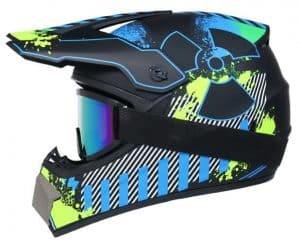Which of the helmets is suitable for trail riding? Do you need a Full-Face Helmet for trail riding? (Aka Full Coverage or Integral helmet). Trail riding is the only time where you might see riders of off-road machines wearing open-face ¾ style helmets.
Maximum head movements while winding your way through obstacles at exceptionally low speeds may be required in some types of trail riding. Some trail riders prefer an open-face helmet because they have better peripheral vision and maybe cooler to wear, but it offers less protection.
With the latest research on Traumatic Brain Injury (TBI) because of concussive hits, (simply means when the brain comes in contact with the skull), it has been revealed to see just how severe a head injury can occur from just a simple knock to the head. The consequences of a head injury are so serious so most new riders choose to use more protective helmets.
If you are more of a casual rider, then you might want to use an open-faced helmet. The full-coverage helmet is ideal for riders that love to push the limits or ride difficult trails downhill and like to drive fast because they offer more protection which downhillers require.
| Helmet Model | Category | Check & Shop Now |
|---|---|---|
| AGV AX9 | Best All-Round | RevZilla | MotoSport | Amazon |
| Arai XD-4 | Best High-End | RevZilla | MotoSport | Amazon |
| Shoei Hornet X2 | Best Touring | RevZilla | MotoSport | Amazon |
| Klim Krios Pro | Best Lightest | RevZilla | MotoSport | Amazon |
| Sedici Viaggio Parlare | Best Entry-Level | RevZilla | MotoSport | Amazon |
| Scorpion EXO-AT950 | Best Modular/Flip-Up | RevZilla | MotoSport | Amazon |
| Schuberth E1 Adventure | Best Quietest | RevZilla | MotoSport | Amazon |
Why Is the Full-Face Helmet So Necessary for Trail Riding?

It is true that some trail riders prefer to wear an open-face helmet, as they may be more comfortable than a full-face helmet, but it offers less protection. The primary reason for a helmet is to provide maximum protection of the head, which is what the full-face or full-coverage helmet offers.
The more protection you need, the greater the risk you are taking, which often means higher crash speeds. There should not be any compromise with safety when it comes to trail riding. A typical ¾ open face helmet (aka Jet helmet) protects the rider, but a full-face helmet does it more.
While some riders do not like the full-face helmet as they prefer the lighter helmet for their rides. Do you choose some extra comfort, or do you want the most protection and safety? Below are the reasons why a full-face helmet is necessary for trail riding.
If You Are in Pursuit of Speed
A race is not considered a race if no one is trying to go as fast as they can. You might not want to ride fast but sooner or later you will find situations where you will be traveling at a rapid rate of speed.
To protect yourself as much as possible in this situation, full protection is necessary, especially for the head. For individuals who love to speed, wearing a full-face helmet is necessary, it is mandatory. The higher the speed the greater the chance of serious head injury or death.
A full-face helmet will not only protect the head from impact when there’s a crash at high speed but will also protect the jaw from injuries.
A Beginning Rider Who is Not After the Speed
You might be someone who does not ride your bike at high speed, you might still need a full-face helmet because you can never choose the accident you will be in. A beginning rider may not be experienced enough to ride around when they see an unusual obstacle, which might be a root or rock.
They are people who do not ride at high speed, but they have a high chance of falling. To protect their head and jaw from injuries, bruises, and scratches, the full coverage helmet is highly recommended.

If The Trail Is Not Friendly for You
Maneuvering the trail is sometimes difficult especially for riders who are not familiar with a new trail. The trail is full of rocks, roots, bumps, puddles, and more. All may cause multiple crashes and that may or may not cause major injuries.
Riding on this kind of trail requires a full-face helmet to protect yourself from multiple injuries.
If You Do Not Want Rocks and Ice on Your Face
There are a lot of incidents where the helmet managed to keep the rider’s head protected, but they received facial injuries. A typical open-faced helmet can protect the back and side of your head while leaving your facial area unprotected.
The inside chin bar of a full-face helmet has a shock-absorbing foam and padding that protects your face from your frontal impacts.
They Are Stronger Than Others
Open-face helmets provide more ventilation than full-face helmets. Presently, modern full-face helmets provide comfort with a good ventilation system.
If the ventilation happens to be the only thing keeping you away from this helmet, then it is time to move. An open-face helmet cannot bear frontal impacts and offers little protection for the face, mouth, and teeth. Full-face helmets have additional foam and padding which offers maximum impact and shock absorption to counter multiple crashes.
When To Use a Full-Face Helmet?
A full-face is ideal for every type of off-road rider including simple trail riding. And certainly, every hardcore rider

needs a full-faced helmet there is no other viable option.
A full-face helmet will protect your face, mouth, and teeth so maybe you will not have to worry about dental and medical bills. A $500 helmet is a better investment than $3000 dental surgery. For this reason, it is also necessary for Enduro riders to acquire a full-faced helmet because there are lots of speeds and downhill riding involved.
Are Full-Face Helmets Safer?
Full-face helmets are safer than any type of helmet. Presently, most of the full-face helmets on the market are tested to a higher certification level compared to the open-face helmets that are available. However, current testing might not be a perfect science, but they do predict the level of protection the gear should provide.
Are Full-Face Helmets Comfortable?
Open-face helmets may be more comfortable when compared to full-face helmets. However, with the modern lightweight materials, more open breathable design, and numerous air vents which allow heat to escape, lots of riders now prefer the feeling of security over the open face ¾ Jet style helmets.
Full-face helmets have gained more popularity, and lots of brands are creating models with designs that offer lightweight and good ventilation same downhill protection.
Are Full-Face Helmets Heavy?
Full-face helmets weigh about 700g-1200g depending on build materials, level of protection, and breathability mostly. The open-faced helmets weigh less than the full-faced. Presently, full-face helmets have become amazingly lightweight with the use of modern materials.
Even though an open-face helmet is presently lighter, a full-face helmet will always outshine the open-face counterpart when it comes to its ability to offer protection. Is a little extra weight more important than protecting your most vital body part, your head?

Related Posts:
Are Lightest Full-Face Helmets Quieter Than Modular Or Flip-Up Helmets?
Top 10 The Lightest Full Face Motorcycle Helmet With Bluetooth
Are Full-Face Helmets More Expensive?
Presently, modern full-face helmets cost between $150-$500. The price is higher than the average open-face helmet. Your helmet is the most significant piece of protective gear to wear while riding, and you should not. I don’t think I will feel safe wearing a cheaper one.
Related Posts:
Top 10 Most Expensive Motorcycle Helmets And 10 Affordable Alternatives!
Why Are Helmets So Expensive? Are Expensive Ones Worth It? Here Are 5 Great Reasons
Are Expensive Motorcycle Helmets Safer? Which 7 Critically Important Factors For Your Safety
Do Full-Face Helmets Come with Detachable Chin Bars?
Only a few full-face helmets come with detachable chin bars. A few helmet manufacturers are presently designing full-face helmets that come with fast detachable chin bars. These chin bars take only a few seconds to remove or detach.
These types of helmets are ideal for riders that are looking for an open-faced helmet with some facial protection. For long-distance riding, one can remove the chin bar and allow more air to flow while reducing the extra weight on your neck.
The chin bar can then be fixed back when you are ready to go wild again to provide maximum protection.
Are Full-Face Helmets Hot?
There are lots of additional air vents, channeling, and breathable materials that make up the full-face helmet, yet the helmet tends to retain heat. It is hotter compared to open-face helmets. Riders can use a hydration pack to help keep cool and well-hydrated.
Pros and Cons of the Full-Face Helmet
Pros:
- Provides a greater amount of protection, and protects the entire face.
- It covers the mouth entirely protecting your teeth.
- It can provide protection from the cold wind, debris, rocks, and insects.
- It has more camera mounting options.
Cons:
- They can be hot; you need to maintain speed to keep the helmet ventilating, and this can be risky.
- They are more expensive, and not all full-face helmets are equal
- They are bulkier and heavier than open-face helmets.
Michael’s Summary and Conclusion
Some people ride without helmets, and they feel they will never have an accident and hit their heads. It only takes one time for everything to change completely, remember the consequences for such an error are much greater than any other type of injury.
Accidents can happen irrespective of how skilled you are. A full-face helmet is highly recommended whenever you ride but note that wearing protective gear does not guarantee an accident-free ride.
A false sense of security can lead to overconfidence which in turn makes you careless. Do not feel you are superman because you are covered in protective gear, always riding to your ability. If you need maximum protection, go for a full-face helmet. It might be a little uncomfortable, but it can save your life.
I believe the older you get the more you realize that you still want to be able to work daily and support your family or take care of your bills. One of the best rules in riding is to stick to whatever makes you feel safest, not what makes you feel comfortable. Full-face helmet types remain the best way to keep your head and face safe from injuries in case you have an accident.

I've diligently categorized my motorcycle gear recommendations into all available categories, with the aim of providing you with a comprehensive analysis that showcases the absolute best options for all your needs. These items are the culmination of in-depth research, extensive testing, and personal use throughout my vast experience of 50+ years in the world of motorcycling. Besides being a passionate rider, I've held leadership positions and offered consultancy services to reputable companies in over 25 countries. To See Top Picks and the Best Prices & Places to Buy: Click Here! |
Information for this article was partially sourced and researched from the following authoritative government, educational and non-profit organizations:
M/M













